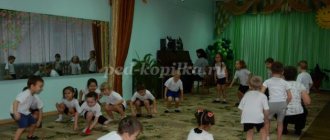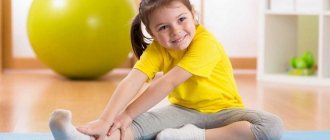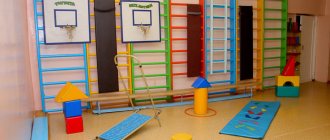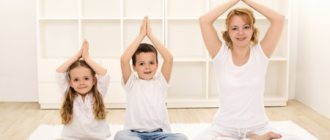| Kind of work: | Essay |
| Date added: | 21.01.2020 |
- This type of work is not a scientific work, it is not a finished final qualifying work!
- This type of work is a finished result of processing, structuring and formatting collected information intended for use as a source of material for independent preparation of educational work.
If you have a hard time understanding this topic, write to me on WhatsApp, we’ll look into your topic, agree on a deadline, and I’ll help you!
If you want to learn how to correctly carry out and write abstracts on any subject, then on the page “what is an abstract and how to do it” I wrote in detail.
Introduction
In modern society, a person experiences a whole range of unfavorable factors: emotional stress, information overload, poor environmental conditions. These factors are very often combined with insufficient physical activity. The combined impact of adverse environmental factors and a sedentary lifestyle has an extremely negative impact on the body, affects its normal functioning and contributes to the development of various diseases.
In such conditions, it is very important to use a number of different means to maintain and strengthen the health of the body. A healthy person is a full-fledged member of society, with a high level of physical and mental performance, good health and inner peace.
One of the activities that has a beneficial effect on the health of the body is morning exercises. In addition to the specific effect that facilitates the process of transition from a state of rest to a state of active wakefulness, performing morning exercises increases the level of general physical activity. For the majority of the urban population, morning exercises are often the only specially organized physical activity.
Like most effects on the body, morning exercises are useful only if they are used correctly, taking into account the peculiarities of the functioning of the body after sleep, as well as the individual characteristics of a particular person.
The main tasks that can be solved with the help of morning exercises:
- Eliminate some of the consequences of sleep (swelling, lethargy, drowsiness, etc.);
- Increase the tone of the nervous system;
- Strengthen the functioning of the body's main systems (cardiovascular, respiratory, endocrine and others).
- Solving these problems will allow you to smoothly and quickly improve the mental and physical performance of the body, preparing it to cope with the significant physical and mental stress that is often found in modern life.
As a result of competent performance of complex morning exercises, optimal excitability of the nervous system is created, heart function improves, blood circulation and breathing increase, which ensures increased delivery of nutrients and oxygen to cells.
After a good workout, you feel drowsiness, lethargy, weakness, increased mental and physical performance, activity, mood and well-being. Physical exercises of morning exercises to enhance lymphatic drainage, increase the circulation of interstitial fluid, and increase venous blood flow. This provides relief from congestion and swelling that often occurs during sleep, especially in middle-aged and elderly people.
Since performing any physical movements is accompanied by an increased release of heat, morning exercises lead to a moderate increase in body temperature. Within certain physiological limits, an increase in body temperature is a positive factor. An increase in temperature accelerates metabolic processes and increases the activity of all organs.
In particular, it increases the speed of transmission of nerve impulses, which, together with other changes, facilitates the processes of controlling various functions of the body by the nervous system, increases the speed and accuracy of reactions, coordination of movements, increases all types of sensitivity, and improves mental performance. Physical gymnastics
The most suitable exercises for morning exercises:
- Stretching exercises Various types of walking;
- General developmental exercises (bending, twisting, squatting, alignment, joint rotation, etc.);
- Stretching exercises (for flexibility);
- Dance moves;
- Light jogging and jumping;
- Breathing exercises.
Morning exercises are a system of specially selected exercises aimed at strengthening large muscle groups and improving the health of the body. Morning exercises create an organized start, a smooth, cheerful mood for those involved: highly excited children are calmed down by actions at a given pace, and sedentary children are drawn into a certain rhythm of work. Therefore, after morning exercises, preschoolers are more balanced, their faces are satisfied and joyful.
By increasing the vitality of the body, morning exercises create favorable conditions for further activities and have a beneficial effect on the development of organization, discipline, and endurance.
As a rule, morning exercises begin with walking, which affects all muscle groups, gradually involving all body systems, but the load on it is insignificant. In order to warm up the foot and increase its flexibility, walking is performed in different ways. Since morning exercises are a daily form of work, it is advisable to diversify the placement of children in space while walking: use movement like a snake, two columns in different directions, diagonally, etc. this will relieve monotony.
The importance of morning exercises is primarily determined by increasing the vital activity of the whole organism. The work of the muscular system activates the cardiovascular and respiratory systems, disinhibits the nervous system, creates conditions for good mental performance, for the transition to an active state of the whole organism.
The joy of muscle sensations and the pleasure of morning exercises create the conditions for preparing preschoolers to do exercises on their own. The development of certain knowledge and skills sufficient for the emergence and independent implementation of the need for physical exercise will help solve the problem of educating children in the need for systematic morning exercises.
The basis of morning exercises is a set of general developmental exercises, which includes 6-8 exercises and involves repeating each of them 6-8 times. The effectiveness of the impact is achieved not so much due to the number of exercises and number of repetitions, but rather due to the quality of execution. A clear action in a given direction, with a certain amplitude, the necessary tension and relaxation of various muscle groups, adherence to rhythm and tempo not only ensure an increase in the performance of the child’s body, but also contributes to the development of coordination in children, influence the formation of correct posture and the physical development of the child as a whole. .
Structure of morning exercises:
1. Introductory part: exercises for the prevention of flat feet, walking.
2. The main part is general developmental exercises; fast running, jumping in place.
3. final part - walking, dance movements, special breathing exercises with a slow long exhalation in the form of reading a quatrain in one or two breaths or game exercises (“the tire went flat”, “the ball burst”).
Morning exercises can be carried out in the form of games and play exercises. To enhance physical activity, a high-intensity outdoor game is carried out, and the morning exercises end with a sedentary game.
Morning exercises are carried out outdoors in the warm season, and under appropriate conditions - throughout the year.
Jumping and speed running can be replaced by endurance running.
The first skills of independently performing morning exercises can be developed by assigning the child to carry out this or that exercise with other children. For example, if there are 6 exercises in a complex, then six children are invited from the group. They stand in a line in front of the others, and each performs only his own exercise from the complex. Then one child is assigned to carry out the entire complex of morning exercises.
The dosage of the load is determined by the musical accompaniment. Subsequently, you can instruct the children to do morning exercises on weekends with their parents or siblings (after appropriate work with the parents), and then ask them to tell the MBOU about it.
General requirements for morning exercises.
Morning exercises are a set of specially selected exercises aimed at solving health-improving, educational and educational problems. It is designed to positively set the child up for the entire coming day. Morning exercises acquire their significance if they are carried out systematically.
Morning exercises are carried out before breakfast. After it is completed, it is necessary to provide some time for the child’s body to transition from motor activity to digestion mode, that is, one should not immediately after completing the lesson proceed to eating or sit down at the table. It is useful to carry out water procedures after gymnastics, which will serve to harden the child’s body. In the warm season, in good weather, it is recommended to do morning exercises in the air, which provides the best healing effect.
When conducting morning exercises indoors, it is necessary to follow hygienic rules - the room must be well ventilated, fresh air must be provided, and the carpet must be clean. Children exercise in lightweight clothing that does not restrict movement and breathing. There is no point in changing into physical education uniform, since the duration of gymnastics is short, especially for young children (6-8 minutes). Shoes for classes should be light - Czechs, sports sneakers. It is allowed to perform exercises in socks, provided that the floor surface is not slippery. If there are no medical contraindications and the room has comfortable conditions - heated floors, children can exercise barefoot.
The exercises used in morning exercises should be simple and familiar to children, learned in physical education classes, and some in music classes or in free time in a group. “Dry” gymnastics with simply demonstrating movements and performing them on a verbal command and counting is not suitable for preschoolers. This is especially true for children, whose entire development is carried out through play. Therefore, exercises at this age are playful and imitative in nature.
Morning exercises can be performed with musical accompaniment. Music simultaneously regulates the tempo and rhythm of movements, thereby facilitating clearer and more correct execution of the exercise, evokes positive emotions and creates a cheerful mood. It should be noted that almost all children can do morning exercises.
OBJECTIVES OF MORNING GYMNASTICS
In addition to health benefits, morning exercises can solve educational and educational problems. Educational objectives include consolidating motor skills and abilities. It is necessary to clarify that this is more typical for children of older preschool age, since the motor experience of a child 3-4 years old is very small, while children 5-7 years old are already familiar with many types of walking, running, jumping, which they study in physical education classes .
But consolidating concepts from other areas of knowledge can also be done for kids. For example, consolidating the count (counting jumps: “One, two, three, four, five - we will jump again”; “One, two, three - freeze”; “One, two, three, four, five, six - we want sit down”; “One, two, three, four, five - we’d better walk”), knowledge about animals, natural phenomena, professions, etc., if the child is in the appropriate image when performing the exercise. Formation of the need for daily physical exercise, development of the child’s aesthetic taste, subject to beautiful and correct demonstration to adults and musical accompaniment, selected in accordance with the nature of movements and age capabilities of children, are educational tasks.
Thus, morning exercises, if certain rules are followed, helps to solve certain problems in the physical and general development of children. Physical exercises in preschool age, when properly selected, contribute to the harmonious and timely development of all functional systems of the child’s body and are the foundation of the health of the future adult.
Application
Complex of morning exercises (younger age 3-4 years)
1. Introductory part.
Children follow each other in arcs and perform play exercises while moving:
- “On a level path” - walking to the rhythm of the poem (read by the teacher) with a change in direction in combination with different types of walking;
- “Giants” - walking on toes, arms raised up;
- “Gnomes” - walking in a half-squat, hands on knees, alternate with normal walking;
- “Planes” - running in all directions throughout the hall, stopping at the signal “Planes are landing” (fast running and switching to slow walking). The run is repeated;
- A ride in a car (to the text of the poem “The Machine” by A. Barto) - children run slowly in different directions, stopping at a signal (green flag - move, red - stop).
2. Final part.
Complex of morning exercises (average age 4-5 years)
1. Introductory part. Exercises with braids:
- I.p. - standing, legs slightly apart (narrow path, braid in lowered arms). Hands forward, hands up, pull the braid, return to IP. (8 times);
- I.p. — standing on his knees, a pigtail in his drunken hands. Hands forward, turn to the right (left), stand straight, return to IP. (4 times in each direction);
- I.p. - sitting cross-legged, with a pigtail behind his back. Hands up, pull the braid, bend forward, return to IP. (8 times);
- I.p. - lying on your back, straight arms with a pigtail behind your head. Raise your legs up, touch your knees with a pigtail (arms forward), return to the I.P. (6 times);
- I.p. — lying on your stomach, stretch your arms forward with a pigtail. Raise your arms, shoulders, head - inhale, return to standing position. - exhale (6 times);
- I.p. — o.s., the braid lies on the floor in front of the child. Jumping through a pigtail back and forth, legs together, alternating with walking in place, hands free (in two steps, 5 times each).
2. Final part.
Complex of morning exercises (senior age 5-6 years)
1. Introductory part . Exercises with sticks:
- I.p. - standing, legs slightly apart, hands with a stick below. The stick on the chest, forcefully lift it up onto the chest, etc. (8 times);
- I.p. - basic stance, stick in the right hand vertically with an overhand grip. 1-3
- circles with your right hand to the left behind your back; 4 - change hand. The same in the other direction (6 times);
- I.p. - feet shoulder-width apart, stick vertically with one end on the floor, hands on the upper end of the stick. 1-3 - grabbing the stick with your hands, bend down - exhale; 4 - reverse movement - inhale (4 times);
- I.p. - basic stance, stick horizontally at the bottom in both hands. 1-2 - move your leg over the stick; 3-4 - i.p. the same with the other leg (4 times);
- I.p. - kneeling, legs apart, stick in hands below. Turn the body to the left, arms up, return to the position. the same in the other direction (4 times);
- I.p. - squat sideways to a stick lying on the floor. While pushing off, move your right leg over the stick (at each count), placing your left leg against it. Do the same in the opposite direction, then straighten up (4 times each);
- I.p. - basic stance, stick vertically with one end on the floor, hand on the upper end of the stick. Jumping on one leg around a stick, the same, but hold the stick with your left hand and jump on your left leg.
2. Final part.
Complex of morning exercises (children age 6-7 years)
1. Introductory part. Exercises with a racket.
- I.p. — o.s., racket in right hand. Spring step in place, arms arbitrarily (12 times);
- I.p. - oh, s., the racket is in the right hand. Half squat, transfer the racket in front of you to the other hand, return to the standing position. (5 times each);
- I.p. - standing, feet shoulder-width apart, racket in right hand, arms up. Half squat, turn your hands down, head down, etc. (4 times). The same, but the racket is in the left hand (4 times);
- I.p. - Same. Half squat, racket over head, etc. (8 times);
- I.p. - Same. Turn the torso to the left, the left hand forward, the right one swings, as when passing, etc., transfer the racket to the left hand (4 times with each hand);
- I.p. - basic stance, racket in the right hand. Lunge to the left, swing the racket, simulating a forward strike from below, etc., transfer the racket to the other hand (4 times with each hand);
- I.p. — o.s., racket in right hand. Step to the right with a turn around yourself, transfer the racket from hand to hand, etc. (8 times). The same in the other direction;
- I.p. — o.s., racket in right hand. Step forward, bend your knee, raise your left leg up, simulating a blow from below with your hand, etc. (8 times). The same with the other leg;
- I.p. - o.s., racket in front of you in your right hand. Step to the left, jump and transfer the racket to your left hand, pause. Same to the right.
2. Final part.
Individual approach to choosing physical activity for morning exercises
Each organism is characterized by a number of specific features. No two organisms on earth are alike. Even in a multicellular organism, no two cells are alike—each is unique and different.
Therefore, in addition to the general principles of the morning exercise complex in its development, it is necessary to take into account the individual characteristics of the body.
When developing a morning exercise complex, the following main factors must be taken into account:
- State of health of the body
- General physical condition of the body
- Individual biological rhythms of the body
- Health status when choosing physical activity for morning exercises.
The state of health of the body should largely determine what exercises should be included in the morning exercise program, as well as the intensity and duration of their implementation. In some cases, morning exercises are contraindicated. However, as a rule, contraindications are temporary. As a rule, the presence and nature of a particular disease does not indicate the need to abandon morning exercises, but requires adjustment of the complex of means used.
Taking into account the physical fitness of the body when choosing physical activity for morning exercises:
A trained person is more physically active than an untrained person. This is due to the fact that the same load causes fewer physiological changes in a trained body than in an untrained body.
The training of a well-prepared person should be longer and include exercises of greater intensity than the training of an unprepared person.
As a well-trained individual, you can incorporate running and even strength exercises (pull-ups, push-ups, kettlebell exercises, etc.) into your workouts. However, excessive fatigue should be avoided. Even a trained person should not consider training as a means of developing endurance or strength.
Research
In my work, I conducted a survey. At the beginning of the 2019-2020 school year, a survey was conducted among primary school students, since in the period from 7 to 10 years old the habit of taking care of one’s physical condition is developed. I interviewed 26 students in grades 1-5.
This survey showed that only 13% (6 people) do morning exercises at home. The remaining 87% (12 people) do morning exercises only at school.
Having developed a simple set of exercises, I began experimenting at home, doing morning exercises with my family, and after two weeks we began to devote 5-10 minutes to exercise in the morning, we felt that exercise. ensures that the body quickly returns to an alert state after sleep; activates physical and mental performance; strengthens and improves immunity
I gave this set of exercises to my friends, and they also began doing morning exercises.
Experiment 1
We divided primary students into two groups: experimental (15 people) and control (27 people).
To instill in primary school students an interest in morning exercises, we have developed a set of exercises that are aimed at developing posture, strengthening vision, improving blood circulation, as well as developing rational breathing and are interesting for children.
We also decided that it would be advisable to carry out morning exercises with musical accompaniment, since performing exercises to music increases the expressiveness of motor actions and helps coordinate the movements of students.
To find out whether exercise affects the performance of students, an experiment was conducted:
- Every day for three working weeks morning exercises were carried out for the control group (students of grades 1, 2, 4 and 5). In the classroom, 10 minutes before the start of the first lesson, I performed the exercise complex we had developed to music, and the children of the experimental group (3rd grade students) did morning exercises on their own.
- Based on the results of the experiment, it was concluded that the children in the control group had improved performance, while the children in the experimental group remained unchanged; those who did not perform morning exercises, their performance decreased.
- Having done morning exercises at the beginning of the school day, children do not get tired, but continue to actively work in lessons throughout the day.
Experiment 2
Another experiment was conducted with children from the experimental and control groups. They were asked to write down the numbers in sequential descending order against time.
The result of this experiment helped to draw a conclusion: students in the control group completed the task faster, and students in the experimental group completed it more slowly.
Conclusion
Based on the results of all the work done, it was concluded that through morning exercises it is possible not only to develop physically and instill an interest in sports, but to increase the performance of children throughout the school day. It is advisable to do morning exercises with musical accompaniment, since music helps to better organize classes, disciplines students, and increases their attention and performance.
As a result of the study, the hypothesis was confirmed.
Bibliography
- Kozyreva, O.V. Health-improving and educational games for schoolchildren./O.V. Kozyreva.-M.: Education, series: School education, 2007
- Makhaneva, M.D. Being friends with physical education means being healthy!” / M.D. Makhaneva.-M.: Sphere, series: Blue Bird, 2009
- Popkov, A.V. Anti-stress plastic gymnastics.-/A.V.Popkov. –M.: Soviet Sport, 2005. -164 p.
- Kopylov Yu.A., Polyanskaya N.V. Physical education and health class in a secondary school. – Moscow “Chistye Prudy”, 2005.
Annex 1
Appendix 2. Questionnaire for students in grades 1-4
“What do schoolchildren think about morning exercises?”
The results are as follows:
1. Do you exercise at home? a) yes b) no
2. Do you enjoy doing it? a) yes b) no
3. How often do you exercise? a) I don’t do exercises b) I do exercises every day c) I do exercises 2-3 times a week d) I do exercises 1 time a week e) I do exercises 2-3 times a month
4. If you do exercises, what exercises do you use? a) push-ups b) squats c) press (lifting the body from a lying position) d) turns e) exercises for the arms
5. Are you involved in the sports section? a) yes b) no
6. Does morning exercise affect your future work? a) yes b) no
7. Would you advise your classmates to do morning exercises? a) yes b) no
8. If my classmates did exercises every day, then I... a) would do it with pleasure b) sometimes I would do it
Hygienic requirements for organizing morning exercises
Hygiene is the science of creating conditions for maintaining human health.
Clothing requirements:
- Clothing made from natural materials (for example, cotton fabrics) is preferable for morning exercises. Natural materials do not prevent the evaporation of sweat from the surface of the skin, and at the same time ensure the preservation of heat emitted by the body, which helps to warm it up after sleep.
- In addition, clothing for exercise should be loose, comfortable, lightweight and not restrict movement. It’s good if clothes for school meet not only hygienic, but also aesthetic requirements. Wearing nice clothes will make your workout more enjoyable and your mood will improve.
- If the course takes place outdoors, then the same requirements apply to shoes. When exercising indoors on a warm, clean floor, shoes should not be worn.
Room requirements:
- The practice room should be relatively spacious, well ventilated, clean and well lit.
- During the warm season, training can be done outdoors. In this case, the body experiences not only the consequences of physical exercise, but also natural factors - the sun, the air - which have a strengthening effect.
Healthy people who tolerate exercise well in the morning can do exercises in the fresh air not only in the warm season, but also in almost any weather. Outdoor training is especially convenient for people who have dogs at home - you can combine your pet's morning walk with hygienic exercises.
Requirements for musical accompaniment:
- It is better to do morning exercises to rhythmic, cheerful music.
- The volume of the music should not be too soft, but not too high, since too loud music causes the development of protective inhibition in the nervous system.
- Cheerful, rhythmic, joyful music enhances the tone of the nervous system, lifts the mood and makes you want to move. This makes waking up much easier and reduces lethargy after sleep.
- Avoid using music that contains disturbing, frightening sounds, because after sleep, when the body is in a sluggish state, it is extremely sensitive to such influences at the level of subconscious perception.
Why do you need to do exercises in the morning?
Morning exercises are a simple set of exercises for the main parts of the body that a person does in the morning after waking up.
After exercise, vitality increases, and the body adjusts to the working day.
Physical exercise not only helps you wake up, but also helps:
- improving blood circulation and lymph flow;
- influx of oxygen into tissues;
- activating brain activity, increasing concentration, improving thought processes;
- increasing endurance;
- strengthening posture;
- acceleration of metabolism;
- reducing joint stiffness;
- strengthening the vestibular apparatus;
- improving mood and relieving irritability.
Exercises for morning exercises have a positive effect on the functioning of the musculoskeletal system and cardiovascular system, and help in the fight against premature aging of the body.
Difficult morning exercises
Morning Exercise Program No. 1
- Walk in place or move in place with outstretched arm movements, squeezing and releasing your fingers. Duration 1 minute.
- Standing, feet shoulder-width apart. Left arm up at your sides, right arm behind your back, stretch and stretch, inhale, return to the starting position, exhale. I repeat, changing the position of the hands. Average temp.
- While standing, raise your toes, extend your arms to the sides - inhale, then return to the starting position - exhale.
- Standing, legs to the sides, left hand up on the waist on the right side; spring fold to the right, repeat the same on the other side. Breathe evenly, at an average pace.
- Standing, throw your left leg back, swing your arms forward, arms relaxed - inhale; starting position - exhale; repeat the same with your right leg.
- Stand, stand on tiptoes, arms at your sides - inhale, lunge your right leg, bend forward, hands touch the floor - exhale, starting position - inhale, the same with the left leg. Speed is average.
Difficult morning exercise number 2.
- Walking with outstretched arms at an accelerated pace. Duration 1 minute.
- Stand with your feet opposite, fingers interlocked. Turn your palms outward, arms up, lift them onto your toes - inhale; straighten your arms, arms down to your sides, return to the starting position - exhale.
- Run (15-20 seconds) slowing down and starting to walk.
- Stand with your legs wide apart, hands on your waist. 1 - body rotation to the left, arms to the side; 2 - 3 - back bends; inhale; 4 — starting position; exhalation; 5 - 8 - the same when rotating to the right. Average temp.
- Lie on your back and stretch your arms to the side. Raise your right leg and then place it to the right until it touches the floor; Raise your leg, starting position. Do the same with your left leg and lower it to the left. Breathe evenly, slowly.
- The starting position is to kneel and then sit on your heels, leaning forward, palms on the floor. 1 - 3 - let the chest slide along the floor, arms first bend and then straighten, move to a resting position on the hips - inhale; 4 - bend your legs, quickly return to the starting position - exhale. Speed is slow.
Complex morning exercises No. 3.
- Standing, feet shoulder-width apart, hands on waist. Move your elbows back, inhale and relax as you exhale.
- Stand with your feet together and your arms down. With your feet out to the side, raise your arms to your shoulders, then return to the starting position. Speed is average.
- Stand with your feet shoulder-width apart, one hand up and the other down. Wave your arms one at a time.
- Stand up with your arms down. Raise your arms to the sides as you inhale and lower them as you exhale. The pace is average.
- Walk in place, raising your knees up, gradually speeding up and slowing down.
- Standing, legs to the sides, hands on the waist. Bend over (exhale) and reach for your fingers. Speed is average.
- Stand with your feet together and your arms bent in front of your chest. Snatch with arms bent for a two count and arms extended for a two count. The pace is average.
- Standing, feet together, arms down. Raise your arms alternately - inhale, lower - exhale. The pace is slow.
- Standing, feet shoulder-width apart, hands on waist. Three side bends of the body, return to the starting position. Speed is average.
- Standing, feet shoulder-width apart, arms down. Perform a springy half-squat with punches forward and backward with your arms. Average temp.
- Calm walking with relaxation (alternating handshakes, legs) for 15 - 20 seconds.
- When walking, alternately raise your arms up - inhale, down - exhale. Speed is slow.







